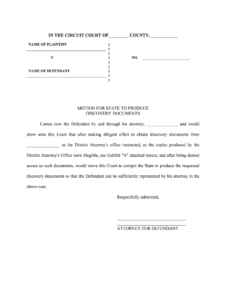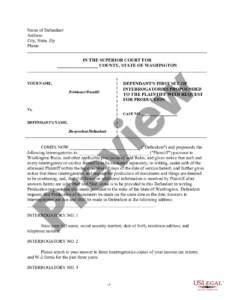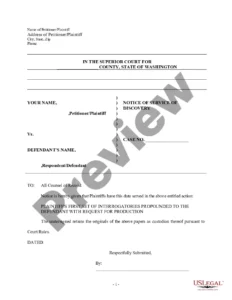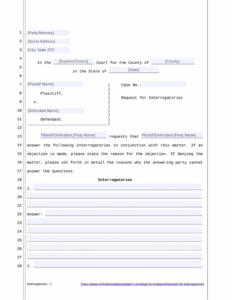Utilizing these pre-designed forms saves time and resources by eliminating the need to draft requests from scratch. The structured format ensures all necessary information is included, reducing the likelihood of incomplete or ineffective requests. This streamlined process contributes to a more efficient and cost-effective discovery phase, benefiting all parties involved. Furthermore, the standardized nature promotes fairness and transparency, ensuring all parties have equal access to crucial information.
This foundation provides a crucial understanding for exploring the specifics of creating, serving, and responding to these essential legal documents. Further discussion will address key components, best practices, and potential challenges related to this critical aspect of legal discovery.
Key Components of a Formal Discovery Request
Effective discovery requests require specific elements to ensure clarity, completeness, and enforceability. Understanding these key components is crucial for both requesting and responding parties.
1. Identifying Information: The requesting party and the party from whom production is sought must be clearly identified. This typically includes names, case numbers, and contact information.
2. Specific Instructions: Clear instructions on the manner of production are essential. This might specify the format (electronic, hard copy, etc.), location, and timeframe for production.
3. Definitions: Precise definitions of terms used within the request are often necessary to avoid ambiguity and ensure all parties understand the scope of the request.
4. Numbered Requests: Individual requests should be numbered sequentially for easy reference and organization, facilitating a clear and structured response.
5. Specific Items Requested: Each request must clearly and specifically describe the documents or items sought. Vague or overly broad requests are often subject to objection.
6. Time Period: A defined time period for which the requested documents or items are relevant should be included. This prevents the production of unnecessarily large volumes of information.
7. Response Instructions: Clear instructions on how the responding party should provide the requested items, including deadlines and acceptable formats, are crucial for a smooth process.
8. Signature and Certification: The request must be signed and certified, affirming the legitimacy and accuracy of the request, in accordance with legal requirements.
Careful attention to these components ensures the efficacy of discovery requests and contributes to a more efficient and just legal process. Proper formatting and specificity minimize disputes and ensure all relevant information is obtained in a timely manner.
How to Create a Formal Discovery Request
Creating a well-crafted discovery request is crucial for obtaining necessary information in legal proceedings. A methodical approach ensures clarity, completeness, and adherence to legal requirements.
1. Consult Local Rules and Templates: Begin by reviewing relevant local rules of procedure and available templates. Jurisdictional variations may exist regarding specific requirements and formatting.
2. Identify Parties: Clearly identify the requesting and responding parties, including full names, case numbers, and contact information. This ensures proper notification and attribution.
3. Define Scope and Terms: Define key terms to avoid ambiguity and ensure all parties have a shared understanding of the request. Specify the scope of the request, including the relevant time period.
4. Number and Structure Requests: Number each request individually for clarity and organization. Use clear and concise language, avoiding jargon and legalese when possible.
5. Specify Items Requested: Describe each requested item with precision. Provide sufficient detail to enable the responding party to locate and identify the requested materials accurately.
6. Specify Production Format: Indicate the preferred format for production (e.g., electronic, hard copy, native format). This streamlines the process and ensures compatibility.
7. Set Deadlines and Instructions: Clearly state the deadline for production and provide specific instructions on how and where to deliver the requested materials.
8. Review and Sign: Carefully review the completed request for accuracy and completeness before signing and serving it according to applicable rules of procedure.
Following these steps helps ensure the effectiveness and enforceability of discovery requests, contributing to a more efficient and fair legal process. Attention to detail and adherence to established procedures are essential for successful information gathering in legal matters.
Careful construction and utilization of standardized forms for requesting the production of documents or other tangible items are essential for effective legal discovery. Understanding the key components, including clear identification of parties, specific instructions, precise definitions, and numbered requests, contributes to a more efficient and transparent process. Adherence to established procedures and local rules ensures the enforceability of these requests and promotes fairness in legal proceedings.
Mastery of these standardized forms empowers legal professionals to navigate the discovery process effectively, minimizing disputes and facilitating the timely exchange of crucial information. This, in turn, contributes to a more just and efficient resolution of legal matters, emphasizing the importance of these tools in the pursuit of justice.



